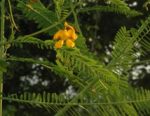 Also called coffeeweed, hemp sesbania, and Colorado River-hemp, this semi-woody, native , tender perennial can be found in moist disturbed areas in the southeastern coastal plain into the piedmont from Virginia to Florida, west to Mississippi. It is a member of the pe family, Fabaceae, that also includes lupine, mimosa, and black locust. Historically, it has been used as a forage and cover crop but is now considered a serious weed in fields of soybean, cotton, sweet potato, and rice where it damages crops by growing over them.
Also called coffeeweed, hemp sesbania, and Colorado River-hemp, this semi-woody, native , tender perennial can be found in moist disturbed areas in the southeastern coastal plain into the piedmont from Virginia to Florida, west to Mississippi. It is a member of the pe family, Fabaceae, that also includes lupine, mimosa, and black locust. Historically, it has been used as a forage and cover crop but is now considered a serious weed in fields of soybean, cotton, sweet potato, and rice where it damages crops by growing over them.
Description: Growing 3-10’ tall, bigpod sesbania has smooth green stems that become woody with age, and pinnately compounded leaves 12” long. Each leaf is made up of twenty to seventy paired leaflets that are narrowly elliptical, smooth, and blunt at the tip and the base. Two to six pea-like flowers are carried in small axillary racemes in late spring to summer. They are yellow or yellow orange, often purple streaks or spots, hand have an upper petal long that the wing or keep petals. The linear seedpods are 4-8” long, are tipped with a small beak, and contain thirty to forty seeds that are truncated at brownish mottled with purple or black.
Control: Control of bigpod sesbania is best accomplished by mechanically removing plants before they set seed and then establishing conditions favorable for beneficial plants that will out-compete sesbania. Mowing to remove the flowers early can be successful if done high enough that desirable plants are allowed to grow. Pre- or post- emergent herbicide do not offer long term control but glyphosate herbicides like RoundUp are effective. Disking before mid summer and burning should not be employed as they stimulates germination, but late disking in fall can be effective. Since seeds remain viable in the soil for more than a year, yearly follow up treatments may be necessary.